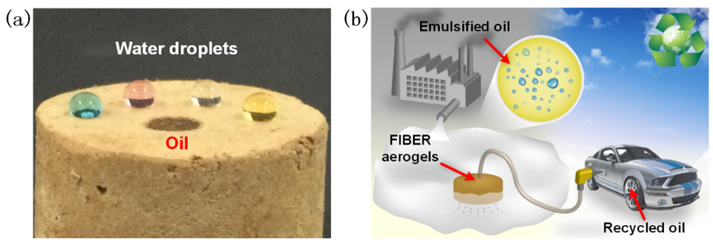Recently, the “Functional Nanofibrous Materials”group led by Prof. BinDing in our college hasmade a breakthrough progress in the area of effective oil/water separation materials. They successfully fabricatedthe three-dimensional (3D) nanofibrous aerogels with ultralow density, high selective wettability and high pore tortuosity viacombiningtheir original “3D-reconstruction of Electrospun Nanofibers” method and traditional “In Situ Surface Functional Modification” technique. The resulting materials exhibitan excellent oil/water emulsion separation performance with high efficiency, low energy consumption and high continuity. The relevant research achievement was published in theauthoritative academic journal (ACS Nano 2015, 9, 3791.)on the title of “Superelastic and Superhydrophobic Nanofiber-Assembled Cellular Aerogels for Effective Separation of Oil/Water Emulsions”. This work successfully extended the application of nanofibrous aerogels to oil/water emulsions separation areas.

(a) Super wettability of nanofibrous aerogels, and (b) schematic showing continuous emulsified oil separation.
In recent years, effective oil/water separation materials are urgent required because ofthe frequent oil spill accident treatment, large amount of petroleum production and fuel purification. Traditional 2D blanket materials (such as oil sorbent mat, oil absorbent) are useful for separation of immiscible oil/water mixtures, but are not effective for emulsified oil/water mixtures.Additionally, despite the commercial ultrafiltration membranes have been successfully applied to separate various industrial emulsions, the shortcomingsof these membranes production, like low porosity, small pore size and short permeation channels, have caused these materials suffer fromlow flux,energy consumption as well as poor reusability, thus, leading to theirimpossibility to meet the relentless demands of effective, fast and continuous oil water separation.
Therefore, the researchers adopteda composite modificationmethod to realize the preciseregulation of the roughness and surface wettability of nanofibrous aerogels, by cooperatively using the nanoparticles and hydrophobic functional monomer during fabrication process.Thus, the pore tortuosity degreecould be effectively increased, and superhydrophobic-superoleophilic feature could be sharply improved, thereby the oil-water emulsion separation performanceof nanofibrousaerogels could get greatpromotion. The obtained aerogelsexhibita high purification accuracyof 99.995%, solely driven by gravity, the emulsions separation flux of aerogels with the thickness of 5mm touch8.1m3 m-2 h-1, which is 3 times higher than that of ultrafiltration membranes with 10 times driven force, and the nanofibrous aerogels can separate over 15 000 times of theirweight of emulsions, which has rarely been found inother porous separation materials. In addition, the nanofibrous aerogelsalso show excellent durability and reusabilityowing to their outstanding antifouling and superelasticity properties.This nanofibrous aerogels areexpected to be widely used in various areas, including the cleanup of oil spills, fuel purification.
This work is supported by the National Natural Science Foundation of China, the Fundamental Research Funds for the Central Universities, and the “DHU Distinguished Young Professor Program”.

